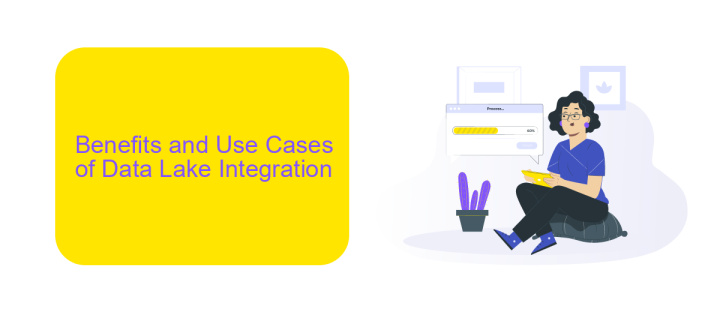Data Lake Integration
Data Lake Integration is a pivotal aspect of modern data management strategies, enabling organizations to efficiently store, process, and analyze vast amounts of diverse data. By seamlessly integrating various data sources into a centralized repository, businesses can unlock valuable insights, drive innovation, and maintain a competitive edge in today's data-driven world. This article explores the key benefits and best practices of Data Lake Integration.
Introduction to Data Lake and Integration
Data lakes have emerged as a revolutionary solution for managing vast amounts of unstructured and structured data. They allow organizations to store data in its raw form, providing a scalable and cost-effective way to handle diverse data types. This flexibility makes data lakes an essential component in modern data architecture.
- Scalability: Easily manage growing volumes of data.
- Flexibility: Store data in its raw format.
- Cost-Effective: Reduce storage costs compared to traditional databases.
Integrating data lakes with various data sources and systems is crucial for maximizing their potential. Tools like ApiX-Drive simplify this process by offering seamless integration capabilities. ApiX-Drive enables automated data transfer between different platforms, ensuring that your data lake remains updated and relevant. This integration is vital for businesses looking to leverage their data for analytics, machine learning, and more.
Benefits and Use Cases of Data Lake Integration

Data Lake Integration offers numerous benefits, including the ability to handle vast amounts of structured and unstructured data. This integration allows organizations to break down data silos, providing a unified repository for all types of data. It enhances data accessibility and enables advanced analytics, machine learning, and real-time data processing. Furthermore, it supports scalability, allowing businesses to grow their data storage and processing capabilities as needed without significant additional investment.
In terms of use cases, Data Lake Integration is invaluable for industries such as finance, healthcare, and retail. For example, in the healthcare sector, it can integrate patient records from various sources to improve diagnostics and treatment plans. In retail, it can combine customer data from online and offline channels to offer personalized shopping experiences. Services like ApiX-Drive facilitate seamless integration by connecting various data sources and automating data workflows, making it easier for organizations to implement and maintain their data lakes efficiently.
Technical Architectural Considerations for Integration

When integrating a Data Lake into your existing architecture, several technical considerations must be addressed to ensure seamless integration and optimal performance. These considerations encompass data ingestion, storage, processing, and security aspects.
- Data Ingestion: Utilize robust ETL (Extract, Transform, Load) tools to streamline the data flow from various sources into the Data Lake. ApiX-Drive can be particularly useful for automating data transfer between multiple platforms.
- Storage: Choose scalable storage solutions that can handle large volumes of data efficiently. Cloud-based storage services like AWS S3 or Azure Data Lake Storage are often preferred.
- Data Processing: Implement distributed processing frameworks such as Apache Spark to manage and analyze large datasets effectively.
- Security: Ensure data encryption both at rest and in transit. Implement role-based access controls (RBAC) to manage permissions and secure sensitive information.
By carefully considering these technical aspects, organizations can achieve a robust and scalable Data Lake integration. Leveraging tools like ApiX-Drive for data ingestion can further enhance the efficiency and reliability of the integration process.
Best Practices for Data Lake Integration

Integrating a data lake effectively requires careful planning and execution to ensure seamless data flow and accessibility. One of the main considerations is to establish a clear data governance framework that defines data ownership, access controls, and compliance requirements. This helps in maintaining data quality and security.
Another crucial aspect is to select the right tools and technologies for data integration. Utilizing automation tools like ApiX-Drive can significantly simplify the process by providing pre-built connectors and workflows for various data sources. This not only reduces manual effort but also minimizes the risk of errors.
- Define a clear data governance framework
- Utilize automation tools like ApiX-Drive
- Ensure data quality and security
- Monitor and optimize data integration processes
Regular monitoring and optimization of data integration processes are essential to ensure that the data lake remains efficient and up-to-date. By following these best practices, organizations can maximize the value of their data lakes and make more informed business decisions.
- Automate the work of an online store or landing
- Empower through integration
- Don't spend money on programmers and integrators
- Save time by automating routine tasks
Conclusion
In conclusion, effective Data Lake Integration is crucial for leveraging the full potential of data within an organization. By ensuring seamless connectivity and data flow between various data sources and the data lake, businesses can achieve greater insights and drive more informed decision-making. The integration process can be complex, requiring careful planning and the right set of tools to manage data ingestion, transformation, and storage efficiently.
Services like ApiX-Drive play a pivotal role in simplifying the integration process by offering automated solutions that connect disparate data sources with ease. With ApiX-Drive, organizations can streamline their data workflows, reduce manual intervention, and maintain data consistency across platforms. As data continues to grow in volume and complexity, adopting robust integration solutions will be essential for maintaining a competitive edge and unlocking the true value of data lakes.
FAQ
What is a Data Lake?
How do I integrate data into a Data Lake?
What are the benefits of integrating data into a Data Lake?
How do I ensure data quality in a Data Lake?
What tools can help automate Data Lake integration?
Apix-Drive is a universal tool that will quickly streamline any workflow, freeing you from routine and possible financial losses. Try ApiX-Drive in action and see how useful it is for you personally. In the meantime, when you are setting up connections between systems, think about where you are investing your free time, because now you will have much more of it.


